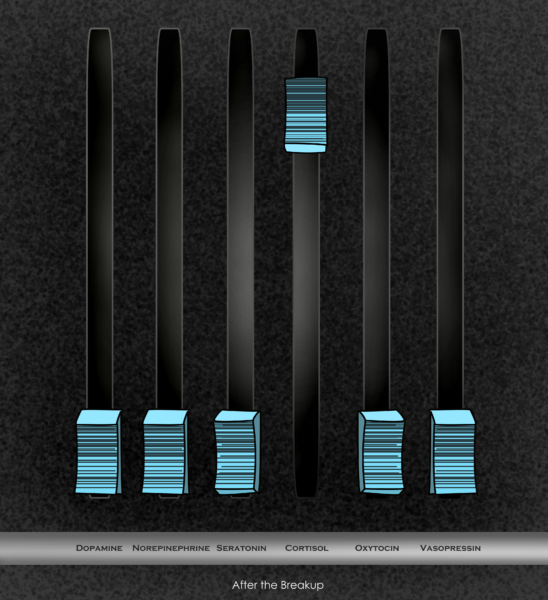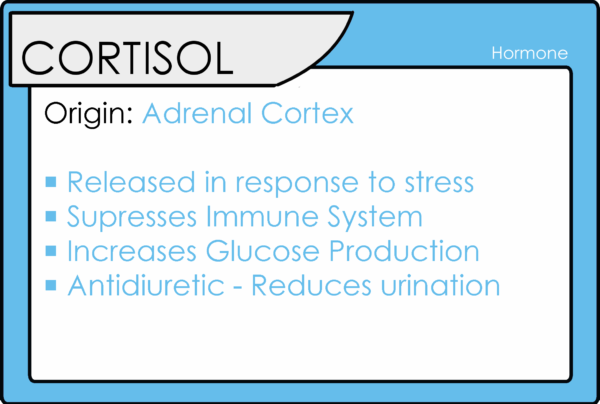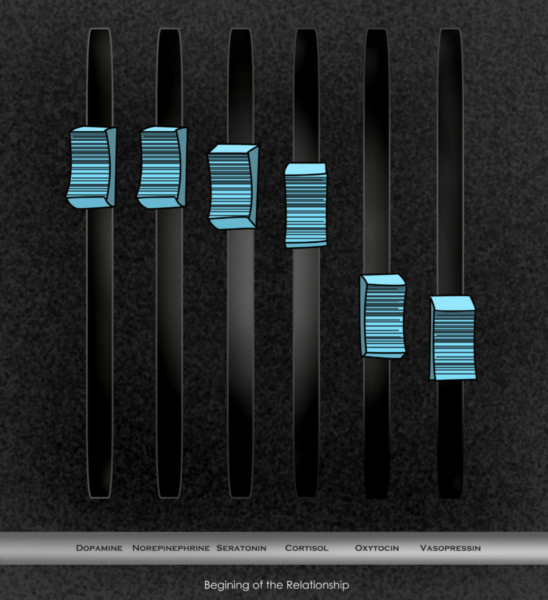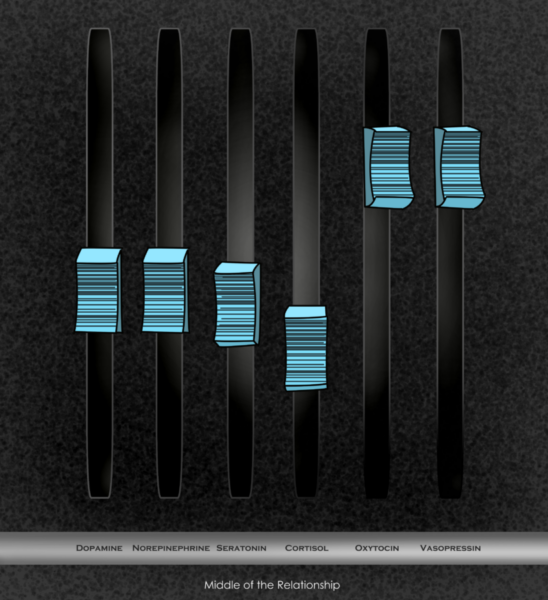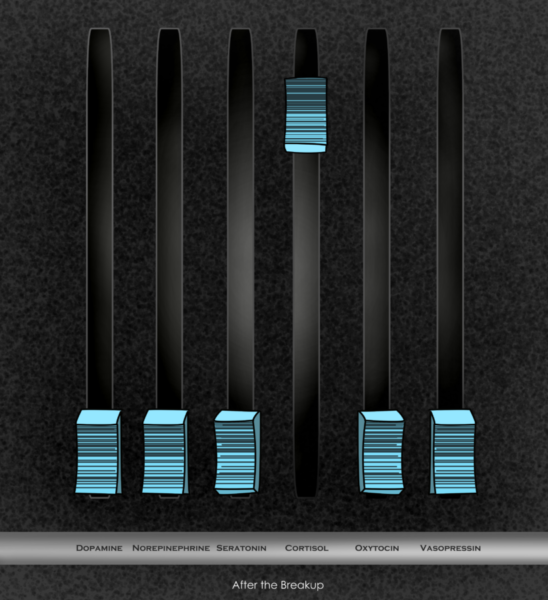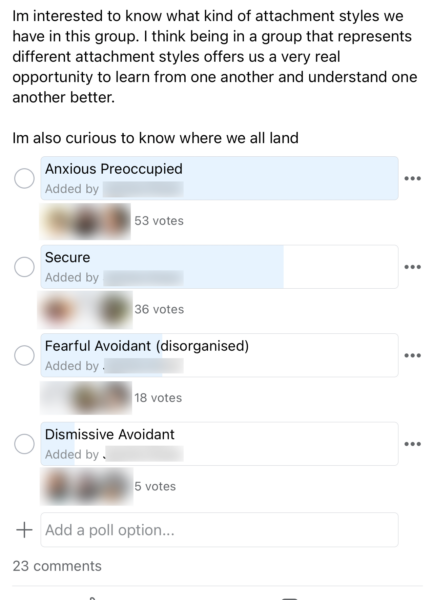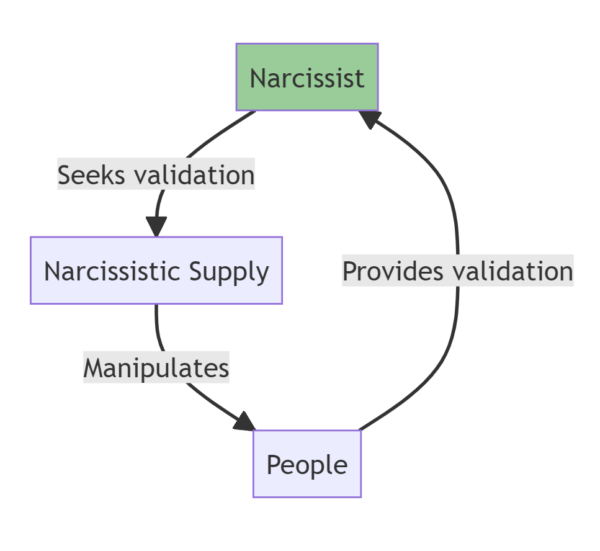Today I’d like to have an in-depth discussion on why your breakup may be affecting you so much.
So, sometimes with articles like these the “reasoning” can get a little dry. After all, we have to dive into science to explain why breakups are so difficult. Of course, me being me, I always try to find an interesting way to spin things.
Here’s my unique take. I believe there are five core reasons for why breakups tend to affect us so much.
- The cortisol factor
- The broader neurochemical factors
- The drug withdrawal factor
- The emotional investment factor
- The codependency issue
Let’s start from the top!

What Are Your Chances of Getting Your Ex Boyfriend Back?
Take the quizThe Cortisol Factor:
I believe it’s crucial to consider the role cortisol plays in explaining why breakups affect us so profoundly.
For those unfamiliar, cortisol is a predominant hormone released after experiencing a breakup. To provide some context, let’s discuss what typically happens neurochemically during a breakup.
You’ll notice a significant spike in cortisol levels.
It’s essential to understand that cortisol is primarily released in response to stress.
Consequently, it can suppress the immune system, increase glucose production, and reduce urination (though the latter isn’t directly relevant to our discussion). W
hat’s truly significant isn’t just the elevated release of cortisol during a breakup, but the prolonged elevated state if one remains in a constant state of stress. This extended state can delay the regression of cortisol levels.
Interestingly, I came across research by Dr. Lee, who posited that while it might take three to four hours for cortisol levels to normalize after a stressful event like an argument or high-stakes meeting, if these levels remain elevated for an extended period, it could take up to six months to stabilize them.
One potential reason a breakup might be affecting you so deeply is the continuous engagement in behaviors that keep your ex at the forefront of your thoughts. This is increasingly common in today’s age of social media.
The platforms offer numerous temptations to check on your ex’s activities. While it might seem harmless, it keeps you in a perpetual state of stress, especially if you see your ex with someone else.
Such sightings can intensify your stress, maintaining high cortisol levels.
The Neurochemical Factors:
Neurochemically speaking, this is what happens to your body at the beginning of a relationship,
Everything is elevated with a special emphasis on:
- Dopamine
- Norepinephrine
- Serotonin
- Cortisol
Of course, as time goes on and that initial honeymoon period wears off this is what happens to your body during the middle of a relationship,
The four initial raised elements go down and oxytocin and vasopressin go up.

What Are Your Chances of Getting Your Ex Boyfriend Back?
Take the quizHere’s what happens when you go through a breakup,
We just talked about the dangers of cortisol spiking and what happens there.
But notice five other things are happening.
I’m actually going to quote from another article on this website, The Anatomy of A Breakup, with regards to what you experience during a breakup.
Lack of Motivation
Well, since Dopamine is your personal supply of motivation and it is now in short supply, you are now not only short on Dopamine but also on motivation.
Fatigue
Dopamine also helps regulate sleep. So, you guessed it. You are about to have yourself some sleepless nights staring at the ceiling wondering what caused your relationship’s untimely end.
Mood Swings
Okay, I’m sure I sound like a broken record right now. But I bet you can guess what chemical controls your mood. I mean if you can’t guess, feel free to look at the cheat sheets I made for you above. If you do, you might notice that serotonin also has a hand in this. The lack of both results in highly unpredictable moods swings.
This is why so many girls these days get dubbed “The Crazy Ex.”
Memory Problems
A low level of Norepinephrine and Serotonin results in lower mental alertness. That, paired with the lack of memory and ability to learn created by a lowered level of Dopamine.
Inability To Concentrate
Norepinephrine, also known as Adrenaline, can make your heart race and butterflies reside in your stomach when you are first falling in love. Adrenaline is incredibly useful and can make you more mentally aware and provide you with lots of energy. However, when the level of Adrenaline drops the ability to focus drops as well. Leaving you feeling like you’ve kind of lost direction.
Sleep Problems
Have you been having some trouble getting substantial sleep? I bet you thought it was just because you missed your Ex. Well partially maybe, but the drop of Dopamine levels can be thanked for your inability to sleep as well.
Loss Of Appetite
Serotonin is responsible for regulating appetite. If you find yourself eating simply to comfort yourself and not because you are actually hungry, you are probably just feeling the effects of a level of Serotonin you aren’t used to since you’ve been in a relationship up until the point.
Lack of Libido
This one varies in most people. Although they still are experiencing a low Serotonin level, they may find motivation elsewhere, making their Ex jealous. However, sleeping with someone solely to make your Ex jealous or think you’ve moved on isn’t necessarily the healthiest thing to do. You’ll wind up either regretting or realizing how pointless that way of thinking is.

What Are Your Chances of Getting Your Ex Boyfriend Back?
Take the quizSuppressed Immune System
This one is the most important, I think. As soon as I realize that I am feeling the effects of a Breakup, I start being super-diligent in taking my vitamins and taking care of myself. Trust me, getting sick AND dealing with heartbreak at the same time is not an easy course.
The Drug Withdrawal Factor
We’ve pretty much established that there’s a surge or drop in hormones and chemicals in your body when you’re on this emotional rollercoaster. I showed you that with the neurochemical factors earlier.
So, when you’re on this wild ride of emotions, it often feels like you’re going through drug addiction withdrawal. I came across this insightful article from The Big Think. It argued that the hormone fluctuations in our brains during a breakup are eerily similar to those experienced during drug withdrawal. MRI scans have shown that the pain of a breakup can look a lot like the pain of a severe burn or a broken arm. (Source)
So, when my clients ask me why a breakup is hitting them harder than they expected, I often tell them that, scientifically speaking, they’re essentially going through drug withdrawal.
They were hooked on the feelings their ex gave them, and now that’s gone.
If you think about how addiction treatments work, they don’t just cut people off; they gradually reduce the drug. But with breakups, it’s like you’re cut off cold turkey, left to handle the aftermath by yourself.
This brings us to another crucial aspect: the emotional investment.
Emotional Investment
I was working on an article yesterday, arguing that not all breakups are created equal.
Typically, someone who breaks up after a month-long relationship hasn’t invested enough for it to hurt long-term, especially when compared to someone who’s been with their partner for two years.
The key difference, I believe, is the emotional investment in the relationship.
The Month Long Example:
Consider someone who’s only been with their ex for a month.
There’s usually not much time or energy poured into that relationship. Sure, the chemistry might be intense, but the sheer amount of time invested isn’t substantial.
Plus, there aren’t usually many future plans or dreams tied into a month-long relationship. You haven’t had ample time to intertwine your lives, routines, or habits.
The Two Year Example:
Now, compare that to someone who’s been with their ex for two years. They’ve invested a lot of time, energy, and even money. They’ve dreamt of the future, maybe even discussed marriage.
Their lives, routines, and habits have become deeply intertwined. If you’re accustomed to certain daily routines, having them suddenly cut off feels jarring. We touched on the drug withdrawal analogy earlier, but cutting out these routines amplifies the pain.
So, it’s crucial to consider the relationship’s duration. Generally, from what I’ve observed, the longer you’ve been with your ex, the more the breakup tends to linger.
The Codependency Issue
Then there’s the issue of codependency.
What I’ve noticed is that a majority of people who visit our website and those I engage with in my coaching sessions often exhibit the anxious attachment style. Our internal surveys support this observation.
The significance of this is that individuals with an anxious attachment style harbor a deep-seated fear of abandonment.

What Are Your Chances of Getting Your Ex Boyfriend Back?
Take the quizWhen this fear is triggered or realized, as in the case of a breakup, they often react in extreme ways to rectify the situation. They might scour the internet for advice on winning their ex back, plead with their ex, or display other anxious, desperate behaviors.
This all ties back to their anxious attachment style.
However, there’s a deeper issue that often goes unnoticed: many of my clients appear to be in highly codependent relationships. This aligns with the understanding that a hallmark trait of codependency is an anxious attachment style. The two are interconnected and can cause the following problems for you:
- Loss of Self-Identity: Individuals with an anxious attachment style often seek validation and reassurance from their partners. When combined with codependency, this can lead to a complete loss of self-identity, where one’s sense of self-worth is entirely dependent on the partner.
- Emotional Dependency: Both anxious attachment and codependency involve a high degree of emotional reliance on a partner. This can create an unhealthy dynamic where one person feels constantly insecure and needs constant reassurance, while the other may feel overwhelmed or trapped.
- Fear of Abandonment: Anxious attachers often fear abandonment, and this fear can be exacerbated in a codependent relationship. The constant need for reassurance can push partners away, ironically leading to the feared outcome.
- Lack of Boundaries: Codependency often involves blurred or non-existent boundaries. When paired with anxious attachment, this can lead to overstepping, a lack of personal space, and an inability to recognize where one person ends and the other begins.
- Increased Conflict: The combination of anxious attachment and codependency can lead to frequent conflicts. The anxious individual may perceive minor issues as threats to the relationship, leading to overreactions and heightened emotions.
- Stagnation of Personal Growth: Being overly focused on a partner’s needs and emotions can stifle personal growth. The individual may neglect their own needs, desires, and aspirations, leading to resentment and unfulfillment.
- Vulnerability to Toxic Relationships: Those with anxious attachment styles and codependent tendencies may find themselves repeatedly drawn to unsuitable or even abusive partners. Their desire for connection and fear of being alone can make them overlook red flags.
- Mental Health Strain: The constant anxiety, fear, and emotional turmoil associated with this combination can take a toll on mental health, leading to issues like depression, anxiety disorders, and other psychological challenges.
Higher Risk Of Being In A Relationship With A Narcissist
The real danger lies in the fact that being in a codependent relationship significantly increases the risk of pairing with a narcissist. A narcissist constantly seeks validation or some form of affirmation from others.
A fitting analogy to describe a relationship with a narcissist involves the narcissist needing a supply of validation.
They’ve mastered the art of manipulating others to provide this validation, which in turn empowers the narcissist, creating a continuous cycle.
The catch is, a codependent individual is often overly eager to please and resolve issues. They struggle with setting boundaries and identifying when they’re involved with a narcissist.
While not all ex-partners I’ve observed are narcissists, many begin to display narcissistic tendencies because the codependent partner hasn’t established clear boundaries, making them susceptible to exploitation.
If a narcissist seeks validation, they know they can turn to someone with codependent tendencies, someone whose life revolves around another, to provide that affirmation.
This manipulation often results in the cyclical nature of on-again, off-again relationships commonly seen in codependent dynamics.
The Three Types Of Codependent Categories
There are typically three types of codependent dynamics:
- Addict + Caretaker
- Parent + Child
- Dysfunctional Adult + Caretaker
Let’s take a moment to go through each:
Addict + Caretaker Dynamic:
Description: In this dynamic, one partner (the addict) is dependent on a substance or behavior, while the other partner (the caretaker) feels responsible for managing the addict’s life and well-being.
Characteristics:
- The addict often denies their addiction or minimizes its impact.
- The caretaker feels compelled to “rescue” or “fix” the addict, often at the expense of their own well-being.
- The relationship is characterized by a cycle of addiction, enabling, and forgiveness.
- The caretaker may feel a sense of purpose or identity in their role, making it difficult to set boundaries or seek help.
Potential Dangers: This dynamic can perpetuate the addiction, as the caretaker’s enabling behaviors prevent the addict from facing the consequences of their actions. It can also lead to burnout and emotional distress for the caretaker.
Parent + Child Dynamic:
Description: One partner assumes a parental role, providing guidance, support, and sometimes discipline, while the other partner behaves in a childlike manner, seeking approval and avoiding responsibility.
Characteristics:
- The “parent” partner often makes decisions for the “child” partner, believing they know what’s best.
- The “child” partner may become reliant on the “parent” for emotional and sometimes financial support.
- There’s an imbalance of power, with the “parent” partner holding more control in the relationship.
Potential Dangers: This dynamic can stifle the growth and independence of the “child” partner. It can also lead to resentment and conflict, as the “child” partner may feel controlled or patronized, while the “parent” partner may feel burdened.
Dysfunctional Adult + Caretaker Dynamic:
Description: One partner (the dysfunctional adult) struggles with adult responsibilities and often behaves irresponsibly or impulsively. The other partner (the caretaker) steps in to manage the consequences and take on additional responsibilities.
Characteristics:
- The dysfunctional adult may struggle with tasks like holding a job, managing finances, or maintaining relationships.
- The caretaker often compensates for the dysfunctional adult’s shortcomings, believing it’s their responsibility to “keep things together.”
- The relationship may be characterized by crises, with the caretaker constantly “putting out fires” caused by the dysfunctional adult’s behavior.
Potential Dangers: The caretaker may become overwhelmed and resentful, feeling like they’re parenting their partner. The dysfunctional adult may become increasingly reliant on the caretaker, leading to a cycle of dependency.
